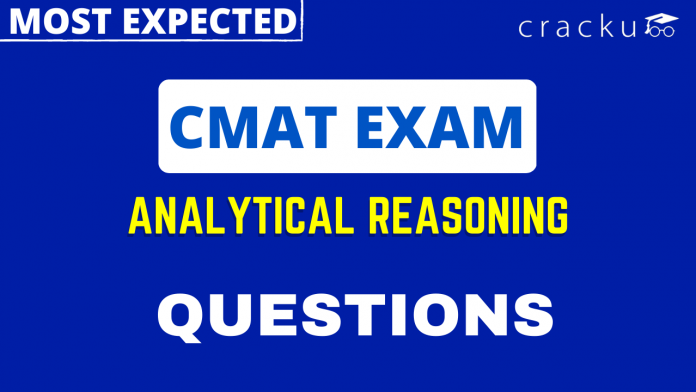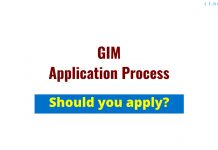CMAT Analytical Reasoning Questions [Download PDF]
Analytical Reasoning is one of the most important topics in the CMAT, and also it is a important section. One can utilize this article which consists of the most important questions regarding Analytical Reasoning. Cracku provides you with the Top 20 very Important Analytical Reasoning Questions for CMAT based on the questions asked in previous exam papers. Click on the link below to download the Analytical Reasoning Questions for CMAT PDF with detailed answers.
Download Analytical Reasoning Questions for CMAT
Enroll to CMAT 2023 Crash Course
Question 1: ‘Music’ is related to ‘Notes’ in the same way as ‘Language’ is related to………………
a) Sentences
b) Combination
c) Grammar
d) Alphabets
e) Syntax
1) Answer (A)
Solution:
Music is composed from notes, similarly a language is made from sentences.
=> Ans – (A)
Question 2: Four of the following five are alike in a certain way and so form a group. Which is the one that does not belong to that group ?
a) Food : Hunger
b) Water : Thirst
c) Air : Suffocation
d) Talent : Education
e) Leg : Lame
2) Answer (D)
Solution:
Without food, we feel hungry, without water we feel thirsty, without air we feel suffocated and without a leg, one is lame.
=> Ans – (D)
Question 3: if’ AxB’ means B is the father of A and ‘A+B’ means A is the wife of B and A /B means A is the brother of B , then what is the relation of J with L in the ‘ J + H / R x L ‘.
a) Daughter
b) Daughter in law
c) Sister in law
d) Cannot determined
e) None of these
3) Answer (B)
Solution:
Expression : J + H / R x L
J is the wife of H, and H is the brother of R.
Also, L is the father of R, => H is the son of L.
Thus, J is the daughter-in-law of L.
=> Ans – (B)
Question 4: Pointing to a boy, Meena said “He is the only grandson of my grandfather”. How is the boy related to Meena?
a) Brother
b) Cousin
c) Uncle
d) Data inadequate
e) None of these
4) Answer (D)
Solution:
The boy is only grandson of Meena’s grandfather.
Thus, the boy can be either Meena’s brother or cousin, hence data is inadequate.
=> Ans – (D)
Question 5: Among five friends J, K, L, M and N each having a different number of pencils. K has more pencils than N but less than L. M has more pencils than L. J neither has the most nor the least number of pencils. Who amongst the following has the lowest number of pencils ?
a) Cannot be determined
b) M
c) N
d) L
e) K
5) Answer (C)
Solution:
K has more pencils than N but less than L, => L > K > N.
M has more pencils than L, => M > L.
Combining above statements, we get : M > L > K > N
J neither has the most nor the least number of pencils.
Thus, N has the least number of pencils.
=> Ans – (C)
Question 6: If two is added to the first three digits and three is subtracted from the last three digits in the number 657489, how many digits in the number thus formed will be multiples of 3 ?
a) One
b) None
c) Two
d) More than three
e) Three
6) Answer (C)
Solution:
Number : 657489
If two is added to the first three digits and three is subtracted from the last three digits, Number
= $(6+2) (5+2) (7+2) (4-3) (8-3) (9-3)$
= $879156$
Thus, only 2 digits are multiples of 3
=> Ans – (C)
Question 7: which of the following values satisfy the inequality ?
P (P-3) < 4P- 12 ?
a) p>4 or p<3
b) 4<=P<7
c) P>3,P<=5
d) 3
e) P=4,P=-3
7) Answer (A)
Solution:
Expression : $P(P-3)<4P-12$
=> $P^2-3P-4P+12<0$
=> $P^2-7P+12<0$
=> $(P-3)(P-4)<0$
=> $P<3$ and $P>4$
=> Ans – (A)
Question 8: If P denotes `+’: ‘R’ denotes ‘÷’: T denotes ‘-‘ and W’ denotes ‘×’; then- 40 R 8 W 10 T 12 P 16 = ?
a) 50
b) 46
c) 30
d) 70
e) None of these
8) Answer (E)
Solution:
given that P denotes `+’: ‘R’ denotes ‘÷’: T denotes ‘-‘ and W’ denotes ‘×’
we need to find value of 40 R 8 W 10 T 12 P 16
= 40 ÷ 8 x 10 – 12 + 16
using BODMAS rule
= 54
Question 9: How many meaningful english words can be formed from the letters ‘’ACER ‘’ using each letter once
a) None
b) One
c) Two
d) Three
e) More than three
9) Answer (D)
Solution:
We can form 3 words from the given word “ACER” i.e CARE, RACE, ACRE.
Hence, option D is the correct answer.
Question 10: How many such pairs of letters are there in the word SCHEDULE (in both forward and backward directions),each of which has as many letters between them in the word as in the English alphabetical series?
a) None
b) One
c) Two
d) Three
e) More than three
10) Answer (D)
Solution:
Word – SCHEDULE
There are 3 pairs of letters which have as many letters between them in the word as in the English alphabetical series.
= (C,E) , (E,D) , (H,L)
=> Ans – (D)
Question 11: Which of the following expression is definitely true if the given expression ‘R<P’ and ‘S>Q’ are definitely true?
a) P>Q=R$\leq$T<S
b) S>T$\geq$R>Q
c) Q>R$\leq$T>P$\geq$S
d) S>T $\geq$ R>Q>P
e) None of these
11) Answer (A)
Solution:
P>Q=R$\leq$T<S
means P is greater than Q and hence, P is greater than R. R is less than or equal to T. T is less than S. Therefore, Q is less than T.
Hence, the correct option is A.
Question 12: Which of the following symbols should replace question mark in the given expression in order to make the expression ‘$A>D$’ and ‘$F \geq C$’ definitely true ?
$A>B \geq C ? D \leq E = F$
a) $>$
b) $<$
c) $\leq$
d) $=$
e) Either $=$ or $\geq$
12) Answer (D)
Solution:
The expression, A>B$\geq$C=D $\leq$ E =F,
Means that A is greater than B which can be greater than or equal to C. Now, if C is equal to D, naturally A is greter than D.
Also, D is less than or equal to E. As E and F are equal, D is less than or equal to F. Hence, C is less than or equal to F.
Question 13: In a row of children facing NORTH Ritesh is twelfth from the left end .Sudhir who is twenty second from right end is fourth to the right of Ritesh . Total how many children are there in the row?
a) 35
b) 36
c) 37
d) 34
e) None of these
13) Answer (C)
Solution:
Ritesh is 12th from the left end. Sudhir is fourth to the right of Ritesh. Hence, Sudhir is 16th from the left end. And also Sudhir is 22nd from the right end. There are 11 people to the left of Ritesh, 21 people to the right of Sudhir and 3 people in between Ritesh and Sudhir. The total number of children’s in the row is: 11 + 3 + 21 + 2(including both Ritesh and Sudhir) = 37. Hence, option C is correct.
Question 14: Vikas walked 9 km towards North, took a left turn and walked 5 km and again took a left turn and walked 9 km and stopped walking. Towards which direction was he facing when he stopped walking?
a) South
b) South-West
c) South-East
d) Cannot be determined
e) None of these
14) Answer (A)
Solution:

Let Vikas started from point A and head north for 9 km to reach B, then he turned left and travelled west for 5 km before reaching C, again he turned left and travelled for 9 km and finally stopped at point D.
Thus, he is facing south direction when he stopped walking.
=> Ans – (A)
Question 15: Which of the following figures represents the relation between ‘Sparrows’, ‘Birds’ and ‘Crows’ ?
a)
b)
c)
d)
e)
15) Answer (B)
Solution:
Sparrows and crows are entirely different. But, both are birds.
=> Ans – (B)










